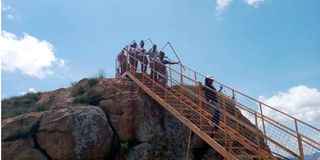Kitui family capitalises on myth surrounding Nzambani Rock to build a business

A group of youth from a local church in Kitui County climb Nzambani rock. The rock has inspired a vibrant camping, hospitality and rock climbing business.
Ivia ya Nzambani (Nzambani Rock), an imposing outcrop standing tall on the fringes of Kitui Town, is one of the most outstanding physical features in Kitui County.
Age old mystery surrounding the rock which towers above the many buildings dotting the vibrant town, inspires awe among visitors. A local family has tapped on the mystery around the rock to carve a rock climbing and camping business.
Tucked in a forested corner of Nzambani Village, Nzambani Rock Sanctuary is a beehive of activity. Tourists sample assorted foods which are served at a state of the ‘art’ restaurant on site.
There is also a bar located at the base of the rock where parents can unwind as their children play in a nearby playground, though the 183-metre high iconic rock remains the main attraction.Some 100 students and a handful of their teachers were among those touring the facility when the Powering SMEs team visited.
“In addition to scaling Nzambi Rock to unwind, our students benefit from the oral literature lessons given on site,” says William Mwangangi, a teacher of English at Kiluva Secondary School, referring to tales about the origin of the rock as told by Mzee Kajiwe Musyoka, 59, a standby historian.
One of the most enduring myths associated with Nzambani Rock revolves around sex change. It is believed that when a person goes around the rock seven times in an anti-clockwise direction, their sex changes.
Visitors are awestruck as Mzee Musyoka regales them with a tale passed down generations of how an adventure in the forest by a girl who was fetching firewood in the forest led to the emergence of the rock.
“The girl known as Nzamba picked an attractive stone as she was collecting firewood alongside her two friends. She decided to take it home to her father for grinding snuff.

Nzambani Rock at Nzambani village in Kitui County.
She raised an alarm when the stone stuck to her body and started to grow. Her friends were unable to disentangle the stone from Nzamba’s body. Shaken, they rushed home and reported the bizarre incident.
The entire neighborhood was shocked on learning Nzamba had turned to a rock” he narrates.Over the years, the rock became a shrine where local elders offered sacrifices. The sex change theory, according to Mzee Musyoka, traces its roots to the 1850s when Dr Ludwig Krapf, a European missionary, toured the region alongside Chief Kivoi, a long distant trader.
A feud emerged between the missionary and locals after the guide died in mysterious circumstances. The missionary escaped the wrath of locals baying for his blood by hiding in Nzambani Rock forest.
To the shock of those who were pursing him, he emerged from the forest dressed like a woman. The locals strongly believed that he had changed from a man to a woman, Mr Musyoka explained.
Although no one has come out to confess a sex change as a result of going round the rock, Ivia ya Nzambani has continued to draw curious visitors in droves.
The biggest clients are youth groups who drive mainly from Nairobi. They often hike the rock and camp at the site during public holidays, activities they post on social media, leading to more visitor. Family picnicsOver the weekends, Nzambani Rock mainly hosts family picnics. Students from local schools as well as those in neighbouring counties keep the address busy on weekdays.
An adult pays Sh200 to scale the rock while a child pays Sh100. Beverages and food are charged separately.
To avert possible accidents, the facility does not allow tourists to take beer before embarking on the rock climbing expedition.

Nzambani Rock at Nzambani village in Kitui County.
“Many of our clients admit that they are drawn by the narrative that going around the rock seven times in an anti-clockwise direction results to a sex change, but curiously, only a handful of the visitors show interest in going round the rock.It takes around 45 minutes to go round the rock once. No one goes beyond two times. Many tourists are only interested in climbing the rock and enjoying meals,” says Mumo Mwendwa, who runs the facility on behalf of the family of the late Kyale Mwendwa, a former politician and Moi-era minister.
Mwendwa says that Ivia ya Nzambani sanctuary was his mother’s idea.
Besides being an advocate for women rights, Susan Nthenya was actively involved in promoting the modern day Kitui County as a tourism destination.She strongly believed tourism as an unmatched potential in developing the countryside through creating employment opportunities and drawing investors.
This is how she came up with the idea of promoting Nzambani Rock as a tourist attraction.The first project, which she undertook in 1999, was setting up a metallic staircase to allow tourists to climb the rock. She also purchased some pieces of land around the base of Nzambani Rock.
In 2004, according to Mwendwa, she received a 99-year lease for Nzambani rock from the government. Work on the project started in 2019, 14 years after she died.Mwendwa plans to set up a hotel at the foot of the rock.
The facility, he says, is designed to have fully furnished guest rooms and a swimming pool. The plan also entails setting up a botanical garden.





